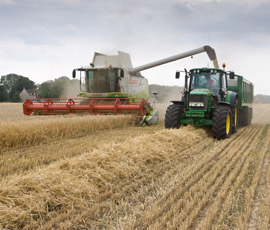2012 – Secrets to success

Variability in wheat yields and quality this year has been unprecedented – but what is behind crop failures or successes?
Although there seems to be little definite evidence to differentiate crops’ performance between or even within farms, a few factors do stand out, says Nick Tapp, head of agri-business at Bidwells.
“The wheat harvest in 2012 will be remembered by much of the industry as the most varied, confused and unpredictable for many years,” he said.
“The outturn to date, with widely varying yields and specific weights, has confounded many.”
However, some varieties had stood out in their poor performance, almost independently of soil type, drilling date or fungicide treatment.
“In the end, some varieties just do not cope with the extremes of wet, cold and gloomy weather, particularly if that weather coincides with flowering.”
Drilling date also proved influential, said Mr Tapp. “Early drilled, well established, well nourished crops seemed to have thrown up a superfluity of tillers, which were kept alive by endless moisture.
“Large amounts of vegetative growth need even more sunshine to turn them into starch, and the sun just did not shine.
“Later drilled crops, perhaps into marginally poorer seedbeds, with what would normally be considered poorer initial yield potential, did not have the opportunity to grow as much vegetation or as many tillers. The results may prove that later drilling in 2011 was right after all.”
Many farmers were relaxed about applying T0 fungicides after the dry winter, but then relentless rain made it very difficult for them to apply T1 when needed, he added.
“Some never caught up and, although late year fusarium is not controlled early on, the build up of disease on unprotected leaf will have left a door open.
“And then failure with a robust ear wash just added insult to injury, and the ear disease complex was free to cause much damage.”
Of course, soil type also played an important role, with well-drained, lighter soils coping far better with the wet summer than heavier land.
“In general, light land produces fewer tillers, grows less vegetation, is less disease prone and lies drier around the roots. In a very wet year all are positive attributes,” said Mr Tapp.
“So the recipe for success in 2012 – farm in an area that did not get the very worst of the rain, on light land, drilled later than would normally be the case, with a robust fungicide programme from the outset, with slightly less nitrogen than planned, advised by the right agronomist, and holding on to crop in spite of all the sell signals in the spring. Not too much to ask?”

